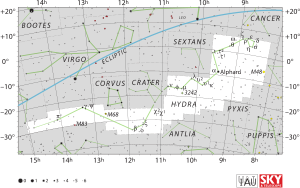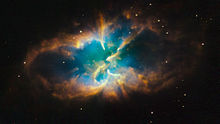羅盤座
| 星座 | |
 | |
| 縮寫 | Pyx |
|---|---|
| 所有格 | Pyxidis |
| 象徵物 | 指南針 |
| 赤經 | 9h |
| 赤緯 | −30° |
| 家族 | 幻之水族 |
| 象限 | SQ2 |
| 面積 | 221平方度 (第65) |
| 主要恆星 | 3 |
| 拜耳/佛氏 恆星 | 10 |
| 有行星的恆星 | 3 |
| 亮度3m以上的恆星 | 0 |
| 距離在10秒差距(32.62光年)內的恆星 | 1 |
| 最亮星 | 天狗五 (3.68m) |
| 最近的恆星 | 格利澤318 (30.13 ly, 9.55 pc) |
| 梅西爾天體 | 0 |
| 流星雨 | 0 |
| 鄰接星座 | 長蛇座 船尾座 船帆座 唧筒座 |
| 可以看見的緯度範圍: +50°至−90°之間 最適合觀賞的月份:三月 | |
羅盤座是黯淡的南天小星座,由法國天文學家尼可拉·路易·拉卡伊18世紀劃分,屬88個現代星座。星座原名「Pyxis」是拉丁語「Pyxis Nautica」的簡寫,意為指南針,與代表圓規的圓規座對應。銀河平面經過羅盤座,星座中最亮的三顆星分別是天狗五、天狗四和天狗六且基本排成直線。3.68的天狗五是羅盤座最亮恆星,離地約880光年,光度約為太陽2.2萬倍。
羅盤座距代表伊阿宋和阿爾戈英雄船隻的老南船座恆星很近,後來南船座拆分成代表龍骨或船體的船底座、代表船尾及尾部甲板的船尾座,還有代表船帆的船帆座。在19世紀,約翰·赫歇爾曾提議把羅盤座更名「船桅座」,但未獲採納。
天狗五東北方向約四度的羅盤座T是再發新星,最隔十餘年到數十年不等就會增亮成七等星。三個恆星系包含系外行星。銀暈中的羅盤座球狀星團距地球約13萬光年,人類本認為這裡沒有球狀星團,估計羅盤座球狀星團是從大麥哲倫星系逃出。[1]
中國星官
[編輯]中國古代傳統中羅盤座天區包括鬼宿的天狗和張宿的、天廟等星官。
- 天狗(張6):羅盤座α(天狗五)、羅盤座β(天狗四)、羅盤座γ(天狗六)。
- 天廟Celestial Temple(張14):唧筒座、羅盤座。代表紀念皇帝先祖的天上廟宇。天廟含有14顆恆星。清欽天監所編《儀象考成》及《儀象考成續編》未收錄此星官,天廟所含恆星的精確位置未知。
歷史
[編輯]
法國天文學家尼可拉·路易·拉卡伊在好望角停留兩年觀察並分類上萬顆南天恆星,在1752年劃分羅盤座並取名「la Boussole」[2][3]。他在歐洲無法觀測的南天星空劃分14個星座,其中13個用象徵啟蒙時代的科學儀器命名[注 1]。1763年,拉卡伊把星座名稱拉丁化成「Pixis Nautica」[4]。古希臘人用羅盤座四顆主要恆星代表神話中伊阿宋和阿爾戈英雄船隻(南船座)的船帆[5]。
普魯士天文學家約翰·波得在1801年星圖上把羅盤座附近恆星劃為測定索座,但未獲後人採納[6]。1844年,約翰·赫歇爾提議把羅盤座更名桅杆座,打算恢復南船座,弗朗西斯·貝利跟進提議,但班傑明·阿普索普·古爾德又恢復拉卡伊命名的羅盤座[4]。
簡介
[編輯]
羅盤座覆蓋220.8度夜空,占0.535%,在88個現代星座排第65,北緯52度以南才能看到完整星座[7][注 2],並以每年二到三月在南半球夜間最清晰[8]。星座北接長蛇座、西挨船尾座、南臨船帆座,東靠唧筒座。1922年,國際天文聯會確定以三字母縮寫「Pyx」代指羅盤座。[9]比利時天文學家尤金·德爾波特1930年正式劃分星座邊界,羅盤座呈八條邊組成的多邊形(見文首信息框)。星座在赤道坐標系統的赤經位於8h 27.7m至9h 27.6m範圍,赤緯在−17.41°−37.29°之間。[10]
拉卡伊用拜耳命名法為羅盤座恆星分配希臘字母α到λ,其中跳過ι和κ。羅盤屬航海儀器,不是「南船」上必不可少的部分,南船座18世紀細分為船底座、船尾座和船帆座,拜耳命名法為恆星分配的希臘字母分入各星座,與羅盤座無關。[4]羅盤座是黯淡的小星座,最亮的三顆星分別是天狗五、天狗四和天狗六且基本排成直線[11],星座內共有41顆星亮度不低於6.5視星等[注 3][7]。
顯著特點
[編輯]恆星
[編輯]
3.68視星等的天狗五是羅盤座最亮星體[13],離地880±30光年[14],屬光譜等級B1.5III的藍白巨星,光度約達太陽太陽2.2萬倍,直徑9.4±0.7倍。估計該星約在1500萬年前形成,擁有12.1±0.6倍太陽質量[15]。宇宙塵埃令該星亮度下降三成,否則應該能達到3.31視星等[13]。3.97視星等的天狗四亮度僅次於天狗五,是光譜等級G7Ib-II的黃亮巨星或超巨星,光度約為太陽435倍[16],距地球420±10光年[14],相隔九弧秒還有12.5視星等的伴星[17]。4.02視星等的天狗六離地207±2光年[14],是光譜等級K3III的橙巨星,核心的氫耗盡後逐漸冷卻並膨脹,直徑達到太陽3.7倍[18]。
拉卡伊在星圖上標示羅盤座κ但沒分配希臘字母,古爾德後來覺得該星亮度足夠,所以分配字母κ[4]。4.62視星等的橙巨星羅盤座κ光譜等級K4/K5III[19],距地球560±50光年[14],光度約為太陽965倍[16],相距2.1弧秒處還有十等星[20]。羅盤座θ是光譜等級M1III的紅巨星和半規則變星,已測得13天和98.3天兩種亮度變化周期,平均亮度4.71視星等[21]。該星離地500±30光年[14],已膨脹到54倍太陽直徑[18]。

羅盤座T位於天狗五東北方向約四度[22],是白矮星與紅矮星組成的聯星系,以1.8小時為公轉周期相互圍繞旋轉。白矮星質量約為太陽八成,聯星系離地約1.55萬光年。[23]羅盤座T是再發新星,基準亮度僅14等,1890、1902、1920、1944、1966和2011年都增至七等星。估計爆發是由白矮星吸收伴星物質並按周期噴發所致。[24]
羅盤座TY是視星等以3.2天周期在6.85至7.5範圍變動的食雙星[25],兩個星體光譜等級都是G5IV,直徑分別是太陽2.2和1.2倍[26],以3.2天軌道周期圍繞彼此旋轉[27]。羅盤座TY屬獵犬座RS型變星,是星斑活動顯著的聯星系[25],距地球184±5光年[14]。該變星輻射X射線,科研人員分析輻射變幅後認為兩星相互吸收並有物質環[28]。羅盤座RZ也是食雙星,兩星形成都不到20萬年且均為光譜等級B7V的熾熱藍白星體,尺寸均為太陽約2.5倍,其中一顆光度約太陽五倍,另一顆約四倍[29]。羅盤座RZ還是天琴座β型變星,亮度以0.66天為周期在8.83到9.72視星等變化[30]。羅盤座XX是人類大力研究的矮造父變星[31],這種星體的脈動周期最長不超過六小時,曾用於宇宙距離尺度,是研究學星震學的重要目標[32]。天文學家確知該星同時還是聯星系後對脈動過程更加了解,主星是光譜等級A4V的白主序星,質量約太陽1.85±0.05倍;伴星估計是光譜等級M3V的紅矮星,質量約太陽三成。兩星估計僅相隔三倍太陽直徑,以1.15天公轉周期圍繞彼此旋轉,主星已變成雞蛋形。[31]
羅盤座AK是光譜等級M5III的紅巨星和半規則變星,亮度在6.09至6.51視星等範圍閃爍[33],同時遵循55.5、57.9、86.7、162.9和232.6天五種周期[21]。羅盤座UZ也是半規則變星,同時是光度約太陽3560倍、表面溫度3482K的碳星,距地球2116光年[16],亮度以159天為周期在6.99至7.83視星等範圍變化[34]。羅盤座VY是第二型造父變星,亮度以1.24天為周期在7.13到7.4視星等變動[35],離地約650光年,光度約太陽45倍[16]。
格利澤318是羅盤座離地最近的星體,是11.85視星等、光譜等級DA5的白矮星[36]。該星距地球26光年[37]或28.7±0.5光年,質量約太陽四成五,光度僅0.15%[38]。WISEPC J083641.12-185947.2是光譜等級T8p的棕矮星,離地約72光年,亮度僅18.79視星等,2011年經紅外天文學發現[39]。
行星
[編輯]羅盤座三顆恆星帶有行星,均由都卜勒光譜學發現。2003年CORALIE光譜儀發現以2.55天軌道周期圍繞HD 73256旋轉的熱木星HD 73256 b,其中HD 73256是光譜等級G9V的黃色恆星,光度約太陽六成九,直徑八成九,質量1.05倍。該星離地約119光年,亮度8.08視星等,約有十億年歷史。[40]2008年高精度徑向速度行星搜索器發現以1260天公轉周期繞HD 73267旋轉的HD 73267 b,主星約有70億年歷史,光譜等級G5V,質量約太陽八成九[41]。葛利斯317是光譜等級M2.5V的紅矮星,離地約50光年,質量約為太陽四成二,有兩顆氣態巨行星,未來有望發現類地行星[42]。
深空天體
[編輯]
羅盤座位於銀河平面,但東部邊緣部分比較黯淡,連同銀河系旋臂一起被物質阻擋。NGC 2818是8.2視星等疏散星團內的行星狀星雲,[43]附近還有疏散星團NGC 2818A[44]。K 1-2也是行星狀星雲,中心的恆星是光譜聯星,兩星相隔很近並產生物質噴流,估計其中一顆星體表面溫度高達8.5萬K[45]。NGC 2627是8.4視星等的疏散星團,可用雙筒望遠鏡觀測[44]。
1995年發現的羅盤座球狀星團已有133±13億年歷史[1],是距地球約13萬光年、離銀河系中心約13.3萬光年的球狀星團,此前人類普遍認為這裡沒有球狀星團[46]。羅盤座球狀星團在銀暈內,與大麥哲倫星系在同平面,估計有可能是逃出該星系的天體[1]。
NGC 2613是10.5視星等的螺旋星系,靠近地球觀測範圍邊緣,呈紡錘形[47]。海因茲2-10是三千萬光年外的矮星系,中心有約百萬倍太陽質量的黑洞,且因恆星形成率很高人稱星暴星系,大量年輕恆星令星系呈藍色[48]。
注釋
[編輯]參考資料
[編輯]- ^ 1.0 1.1 1.2 Irwin, M. J.; Demers, Serge; Kunkel, W. E. The PYXIS Cluster: A Newly Identified Galactic Globular Cluster. Astrophysical Journal Letters. 1995, 453: L21. Bibcode:1995ApJ...453L..21I. doi:10.1086/513301.
- ^ Ridpath, Ian. Lacaille's Southern Planisphere of 1756. Star Tales. Self-published. [2021-03-26]. (原始內容存檔於2021-03-12).
- ^ Lacaille, Nicolas Louis. Relation abrégée du Voyage fait par ordre du Roi au cap de Bonne-espérance. Mémoires de l'Académie Royale des Sciences. 1756: 519–592 [589] [2021-03-26]. (原始內容存檔於2021-03-04).
- ^ 4.0 4.1 4.2 4.3 4.4 Wagman, Morton. Lost Stars: Lost, Missing and Troublesome Stars from the Catalogues of Johannes Bayer, Nicholas Louis de Lacaille, John Flamsteed, and Sundry Others. Blacksburg, Virginia: The McDonald & Woodward Publishing Company. 2003: 6–7, 261–262. ISBN 978-0-939923-78-6.
- ^ Ridpath, Ian. Eyewitness Companions: Astronomy. London, England: DK Publishing (Dorling Kindersley). 2006: 210. ISBN 978-0-7566-4845-9.
- ^ Ridpath, Ian. Lochium Funis. Star Tales. Self-published. 1988 [2021-03-26]. (原始內容存檔於2020-08-03).
- ^ 7.0 7.1 7.2 Ridpath, Ian. Constellations: Lacerta–Vulpecula. Star Tales. self-published. [2021-03-26]. (原始內容存檔於2021-03-12).
- ^ Sasaki, Chris; Boddy, Joe. Constellations: the stars and stories. Sterling Publishing Company, Inc. 2003: 96 [2021-03-26]. ISBN 978-1-4027-0800-8. (原始內容存檔於2021-04-24).
- ^ Russell, Henry Norris. The New International Symbols for the Constellations. Popular Astronomy. 1922, 30: 469. Bibcode:1922PA.....30..469R.
- ^ Pyxis, Constellation Boundary. The Constellations (International Astronomical Union). [2021-03-26]. (原始內容存檔於2021-03-24).
- ^ Moore, Patrick; Tirion, Wil. Cambridge Guide to Stars and Planets. Cambridge, United Kingdom: Cambridge University Press. 1997: 118 [2021-03-26]. ISBN 978-0-521-58582-8.
- ^ Bortle, John E. The Bortle Dark-Sky Scale. Sky & Telescope. Sky Publishing Corporation. 2001-02 [2019-04-08]. (原始內容存檔於2019-04-08).
- ^ 13.0 13.1 Kaler, Jim. Alpha Pyxidis. Stars. University of Illinois. [2021-03-26]. (原始內容存檔於2020-11-05).
- ^ 14.0 14.1 14.2 14.3 14.4 14.5 van Leeuwen, F. Validation of the new Hipparcos reduction. Astronomy and Astrophysics. 2007, 474 (2): 653–664 [2021-03-26]. Bibcode:2007A&A...474..653V. arXiv:0708.1752
 . doi:10.1051/0004-6361:20078357. (原始內容存檔於2016-04-02).
. doi:10.1051/0004-6361:20078357. (原始內容存檔於2016-04-02).
- ^ Nieva, María-Fernanda; Przybilla, Norbert. Fundamental properties of nearby single early B-type stars. Astronomy & Astrophysics. 2014, 566: 11. Bibcode:2014A&A...566A...7N. arXiv:1412.1418
 . doi:10.1051/0004-6361/201423373.
. doi:10.1051/0004-6361/201423373.
- ^ 16.0 16.1 16.2 16.3 McDonald, I.; Zijlstra, A. A.; Boyer, M. L. Fundamental Parameters and Infrared Excesses of Hipparcos Stars. Monthly Notices of the Royal Astronomical Society. 2012, 427 (1): 343–357. Bibcode:2012MNRAS.427..343M. arXiv:1208.2037
 . doi:10.1111/j.1365-2966.2012.21873.x.
. doi:10.1111/j.1365-2966.2012.21873.x.
- ^ Beta Pyxidis. SIMBAD Astronomical Database. Centre de Données astronomiques de Strasbourg. [2021-03-26]. (原始內容存檔於2020-08-06).
- ^ 18.0 18.1 Pasinetti Fracassini, L. E.; Pastori, L.; Covino, S.; Pozzi, A. Catalogue of Apparent Diameters and Absolute Radii of Stars (CADARS) – Third edition – Comments and statistics. Astronomy & Astrophysics. 2001, 367 (2): 521–524. Bibcode:2001A&A...367..521P. arXiv:astro-ph/0012289
 . doi:10.1051/0004-6361:20000451.
. doi:10.1051/0004-6361:20000451.
- ^ Kappa Pyxidis. SIMBAD Astronomical Database. Centre de Données astronomiques de Strasbourg. [2021-03-26]. (原始內容存檔於2020-08-06).
- ^ Privett, Grant; Jones, Kevin. The Constellation Observing Atlas. New York, New York: Springer Science & Business Media. 2013: 168 [2021-03-26]. ISBN 978-1-4614-7648-1. (原始內容存檔於2021-04-24).
- ^ 21.0 21.1 Tabur, V.; Bedding, T.R. Long-term photometry and periods for 261 nearby pulsating M giants. Monthly Notices of the Royal Astronomical Society. 2009, 400 (4): 1945–1961. Bibcode:2009MNRAS.400.1945T. arXiv:0908.3228
 . doi:10.1111/j.1365-2966.2009.15588.x.
. doi:10.1111/j.1365-2966.2009.15588.x.
- ^ Motz, Lloyd; Nathanson, Carol. The Constellations. New York, New York: Doubleday. 1988: 383–384 [2021-03-26]. ISBN 978-0-385-17600-2.
- ^ Chesneau, O.; Meilland, A.; Banerjee, D. P. K.; Le Bouquin, J.-B.; McAlister, H.; Millour, F.; Ridgway, S. T.; Spang, A.; ten Brummelaar, T.; Wittkowski, M.; Ashok, N. M.; Benisty, M.; Berger, J.-P.; Boyajian, T.; Farrington, Ch.; Goldfinger, P. J.; Merand, A.; Nardetto, N.; Petrov, R.; Rivinius, Th.; Schaefer, G.; Touhami, Y.; Zins, G. The 2011 outburst of the recurrent nova T Pyxidis. Evidence for a face-on bipolar ejection. Astronomy & Astrophysics. 2011, 534: 5. Bibcode:2011A&A...534L..11C. arXiv:1109.4534
 . doi:10.1051/0004-6361/201117792. L11.
. doi:10.1051/0004-6361/201117792. L11.
- ^ Davis, Kate. T Pyxidis: Enjoy the Silence. Variable Star of the Month. American Association of Variable Star Observers. 2011-04-19 [2021-03-26]. (原始內容存檔於2021-03-09).
- ^ 25.0 25.1 Watson, Christopher. AK Pyxidis. The International Variable Star Index. American Association of Variable Star Observers. 2010-01-04 [2021-03-26]. (原始內容存檔於2020-08-06).
- ^ S trassmeier, Klaus G. Starspots. The Astronomy and Astrophysics Review. 2009, 17 (3): 251–308. Bibcode:2009A&ARv..17..251S. doi:10.1007/s00159-009-0020-6.
- ^ Andersen, J.; Popper, D. M. The G-type eclipsing binary TY Pyxidis.. Astronomy and Astrophysics. 1975, 39: 131–134. Bibcode:1975A&A....39..131A.
- ^ Pres, Pawel; Siarkowski, Marek; Sylwester, Janusz. Soft X-ray imaging of the TY Pyx binary system - II. Modelling the interconnecting loop-like structure. Monthly Notices of the Royal Astronomical Society. 1995, 275 (1): 43–55. Bibcode:1995MNRAS.275...43P. doi:10.1093/mnras/275.1.43.
- ^ Bell, S. A.; Malcolm, G. J. RZ Pyxidis – an early-type marginal contact binary. Monthly Notices of the Royal Astronomical Society. 1987, 227 (2): 481–500. Bibcode:1987MNRAS.227..481B. ISSN 0035-8711. doi:10.1093/mnras/227.2.481.
- ^ Watson, Christopher. RZ Pyxidis. The International Variable Star Index. American Association of Variable Star Observers. 2010-01-04 [2021-03-26]. (原始內容存檔於2020-08-06).
- ^ 31.0 31.1 Aerts, C.; Handler, G.; Arentoft, T.; Vandenbussche, B.; Medupe, R.; Sterken, C. The δ Scuti star XX Pyx is an ellipsoidal variable. Monthly Notices of the Royal Astronomical Society. 2002, 333 (2): L35–L39. Bibcode:2002MNRAS.333L..35A. doi:10.1046/j.1365-8711.2002.05627.x.
- ^ Templeton, Matthew. Delta Scuti and the Delta Scuti Variables. Variable Star of the Season. AAVSO (American Association of Variable Star Observers). 2010-07-16 [2021-03-26]. (原始內容存檔於2021-02-16).
- ^ Watson, Christopher. AK Pyxidis. The International Variable Star Index. American Association of Variable Star Observers. 2009-08-25 [2021-03-26]. (原始內容存檔於2020-08-06).
- ^ Otero, Sebastian Alberto. AK Pyxidis. The International Variable Star Index. American Association of Variable Star Observers. 2012-04-15 [2021-03-26]. (原始內容存檔於2020-08-06).
- ^ Wils, Patrick. VY Pyxidis. AAVSO Website. American Association of Variable Star Observers. 2011-11-15 [2021-03-26]. (原始內容存檔於2020-08-06).
- ^ Pancino, E.; Altavilla, G.; Marinoni, S.; Cocozza, G.; Carrasco, J. M.; Bellazzini, M.; Bragaglia, A.; Federici, L.; Rossetti, E.; Cacciari, C.; Balaguer Núñez, L.; Castro, A.; Figueras, F.; Fusi Pecci, F.; Galleti, S.; Gebran, M.; Jordi, C.; Lardo, C.; Masana, E.; Monguió, M.; Montegriffo, P.; Ragaini, S.; Schuster, W.; Trager, S.; Vilardell, F.; Voss, H. The Gaia spectrophotometric standard stars survey – I. Preliminary results. Monthly Notices of the Royal Astronomical Society. 2012, 426 (3): 1767–1781. Bibcode:2012MNRAS.426.1767P. arXiv:1207.6042
 . doi:10.1111/j.1365-2966.2012.21766.x.
. doi:10.1111/j.1365-2966.2012.21766.x.
- ^ Sion, Edward M. 1.The White Dwarfs Within 20 Parsecs of the Sun: Kinematics and Statistics. The Astronomical Journal. 2009, 138 (6): 1681–1689. Bibcode:2009AJ....138.1681S. arXiv:0910.1288
 . doi:10.1088/0004-6256/138/6/1681.
. doi:10.1088/0004-6256/138/6/1681.
- ^ Subasavage, John P.; Jao, Wei-Chun; Henry, Todd J.; Bergeron, P.; Dufour, P.; Ianna, Philip A.; Costa, Edgardo; Méndez, René A. The Solar Neighborhood. XXI. Parallax Results from the CTIOPI 0.9 m Program: 20 New Members of the 25 Parsec White Dwarf Sample. The Astronomical Journal. 2009, 137 (6): 4547–4560. Bibcode:2009AJ....137.4547S. arXiv:0902.0627
 . doi:10.1088/0004-6256/137/6/4547.
. doi:10.1088/0004-6256/137/6/4547.
- ^ Kirkpatrick, J. Davy; Gelino, Christopher R.; Cushing, Michael C.; Mace, Gregory N.; Griffith, Roger L.; Skrutskie, Michael F.; Marsh, Kenneth A.; Wright, Edward L.; Eisenhardt, Peter R.; McLean, Ian S.; Mainzer, Amanda K.; Burgasser, Adam J.; Tinney, C. G.; Parker, Stephen; Salter, Graeme. Further Defining Spectral Type "Y" and Exploring the Low-mass End of the Field Brown Dwarf Mass Function. The Astrophysical Journal. 2012, 753 (2): 156. Bibcode:2012ApJ...753..156K. arXiv:1205.2122
 . doi:10.1088/0004-637X/753/2/156.
. doi:10.1088/0004-637X/753/2/156.
- ^ Udry, S.; Mayor, M.; Clausen, J. V.; Freyhammer, L. M.; Helt, B. E.; Lovis, C.; Naef, D.; Olsen, E. H.; Pepe, F. The CORALIE survey for southern extra-solar planets X. A Hot Jupiter orbiting HD 73256. Astronomy and Astrophysics. 2003, 407 (2): 679–684. Bibcode:2003A&A...407..679U. arXiv:astro-ph/0304248
 . doi:10.1051/0004-6361:20030815.
. doi:10.1051/0004-6361:20030815.
- ^ Moutou, C.; Mayor, M.; Lo Curto, G.; Udry, S.; Bouchy, F.; Benz, W.; Lovis, C.; Naef, D.; Pepe, F.; Queloz, D.; Santos, N. C. The HARPS search for southern extra-solar planets XVII. Six long-period giant planets around BD −17 0063, HD 20868, HD 73267, HD 131664, HD 145377, HD 153950. Astronomy and Astrophysics. 2009, 496 (2): 513–519 [2021-03-26]. Bibcode:2009A&A...496..513M. arXiv:0810.4662
 . doi:10.1051/0004-6361:200810941. (原始內容存檔於2021-04-20).
. doi:10.1051/0004-6361:200810941. (原始內容存檔於2021-04-20).
- ^ Anglada-Escude, Guillem; Boss, Alan P.; Weinberger, Alycia J.; Thompson, Ian B.; Butler, R. Paul; Vogt, Steven S.; Rivera, Eugenio J. Astrometry and radial velocities of the planet host M dwarf Gliese 317: new trigonometric distance, metallicity and upper limit to the mass of Gliese 317 b. The Astrophysical Journal. 2012, 764 (1): 37A. Bibcode:2012ApJ...746...37A. arXiv:1111.2623
 . doi:10.1088/0004-637X/746/1/37.
. doi:10.1088/0004-637X/746/1/37.
- ^ Inglis, Mike. Astronomy of the Milky Way: Observer's Guide to the Southern Sky. New York, New York: Springer. 2004 [2021-03-26]. ISBN 1-85233-742-7. (原始內容存檔於2021-04-24).
- ^ 44.0 44.1 Inglis, Mike. Observer's Guide to Star Clusters. New York, New York: Springer Science & Business Media. 2013: 202–203 [2021-03-26]. ISBN 978-1-4614-7567-5. (原始內容存檔於2021-04-24).
- ^ Exter, K. M.; Pollacco, D. L.; Bell, S. A. The planetary nebula K 1-2 and its binary central star VW Pyx (PDF). Monthly Notices of the Royal Astronomical Society. 2003, 341 (4): 1349–1359 [2021-03-26]. Bibcode:2003MNRAS.341.1349E. doi:10.1046/j.1365-8711.2003.06505.x.[失效連結]
- ^ Sarajedini, Ata; Geisler, Doug. Deep Photometry of the Outer Halo Globular Cluster in PYXIS. Astronomical Journal. 1996, 112: 2013. Bibcode:1996AJ....112.2013S. doi:10.1086/118159.
- ^ O'Meara, Stephen James. Steve O'Meara's Herschel 400 Observing Guide. Cambridge, United Kingdom: Cambridge University Press. 2007 [2021-03-26]. ISBN 978-0-521-85893-9. (原始內容存檔於2021-04-24).
- ^ Henize 2–10: A Surprisingly Close Look at the Early Cosmos. Chandra X-Ray Observatory. NASA. [2021-03-26]. (原始內容存檔於2021-01-25).
